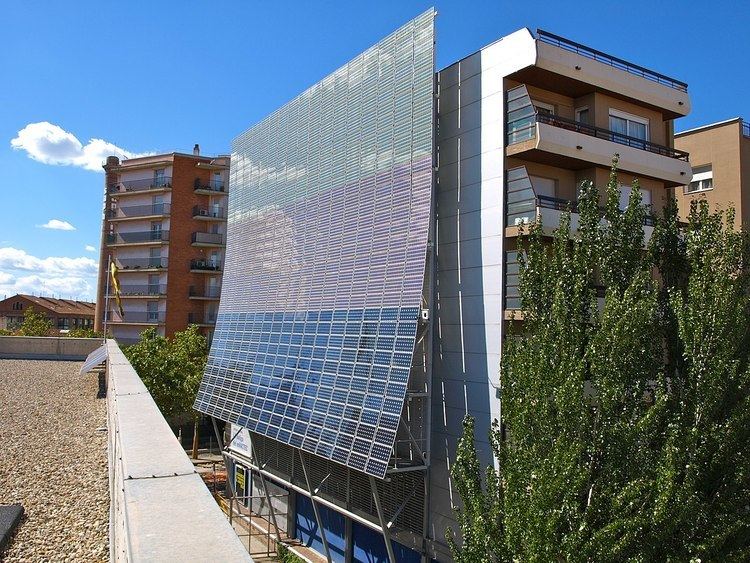 | ||
Building-integrated photovoltaics (BIPV) are photovoltaic materials that are used to replace conventional building materials in parts of the building envelope such as the roof, skylights, or facades. They are increasingly being incorporated into the construction of new buildings as a principal or ancillary source of electrical power, although existing buildings may be retrofitted with similar technology. The advantage of integrated photovoltaics over more common non-integrated systems is that the initial cost can be offset by reducing the amount spent on building materials and labor that would normally be used to construct the part of the building that the BIPV modules replace. These advantages make BIPV one of the fastest growing segments of the photovoltaic industry.
Contents
- History
- Forms
- Transparent and translucent photovoltaics
- Government subsidies
- European Union
- USA
- China
- Other integrated photovoltaics
- References
The term building-applied photovoltaics (BAPV) is sometimes used to refer to photovoltaics that are a retrofit – integrated into the building after construction is complete. Most building-integrated installations are actually BAPV. Some manufacturers and builders differentiate new construction BIPV from BAPV.
History
PV applications for buildings began appearing in the 1970s. Aluminum-framed photovoltaic modules were connected to, or mounted on, buildings that were usually in remote areas without access to an electric power grid. In the 1980s photovoltaic module add-ons to roofs began being demonstrated. These PV systems were usually installed on utility-grid-connected buildings in areas with centralized power stations. In the 1990s BIPV construction products specially designed to be integrated into a building envelope became commercially available. A 1998 doctoral thesis by Patrina Eiffert, entitled An Economic Assessment of BIPV, hypothesized that one day there would an economic value for trading Renewable Energy Credits (RECs). A 2011 economic assessment and brief overview of the history of BIPV by the U.S. National Renewable Energy Laboratory suggests that there may be significant technical challenges to overcome before the installed cost of BIPV is competitive with photovoltaic panels. However, there is a growing consensus that through their widespread commercialization, BIPV systems will become the backbone of the zero energy building (ZEB) European target for 2020. Despite technical promise, social barriers to widespread use have also been identified, such as the conservative culture of the building industry and integration with high-density urban design. These authors suggest enabling long-term use likely depends on effective public policy decisions as much as the technological development.
Forms
Building-Integrated Photovoltaic modules are available in several forms.
What is BIPV?
Recently (in 2011-2016), Australian researchers have been working on developing the new approaches to implementing the unconventional BIPV systems and technologies, including solar photovoltaic windows of high visible transparency capable of providing significant energy savings due to superior thermal insulation properties and solar radiation control. Significant electric energy outputs were obtained from installation-ready framed PV window systems.
Transparent and translucent photovoltaics
Transparent solar panels use a tin oxide coating on the inner surface of the glass panes to conduct current out of the cell. The cell contains titanium oxide that is coated with a photoelectric dye.
Most conventional solar cells use visible and infrared light to generate electricity. In contrast, the innovative new solar cell also uses ultraviolet radiation. Used to replace conventional window glass, or placed over the glass, the installation surface area could be large, leading to potential uses that take advantage of the combined functions of power generation, lighting and temperature control.
Another name for transparent photovoltaics is “translucent photovoltaics” (they transmit half the light that falls on them). Similar to inorganic photovoltaics, organic photovoltaics are also capable of being translucent.
Government subsidies
In some countries, additional incentives, or subsidies, are offered for building-integrated photovoltaics in addition to the existing feed-in tariffs for stand-alone solar systems. Since July 2006 France offered the highest incentive for BIPV, equal to an extra premium of EUR 0.25/kWh paid in addition to the 30 Euro cents for PV systems. These incentives are offered in the form of a rate paid for electricity fed to the grid.
European Union
USA
China
Further to the announcement of a subsidy program for BIPV projects in March 2009 offering RMB20 per watt for BIPV systems and RMB15/watt for rooftop systems, the Chinese government recently unveiled a photovoltaic energy subsidy program “the Golden Sun Demonstration Project”. The subsidy program aims at supporting the development of photovoltaic electricity generation ventures and the commercialization of PV technology. The Ministry of Finance, the Ministry of Science and Technology and the National Energy Bureau have jointly announced the details of the program in July 2009. Qualified on-grid photovoltaic electricity generation projects including rooftop, BIPV, and ground mounted systems are entitled to receive a subsidy equal to 50% of the total investment of each project, including associated transmission infrastructure. Qualified off-grid independent projects in remote areas will be eligible for subsidies of up to 70% of the total investment. In mid November, China’s finance ministry has selected 294 projects totaling 642 megawatts that come to roughly RMB 20 billion ($3 billion) in costs for its subsidy plan to dramatically boost the country’s solar energy production.
Other integrated photovoltaics
Vehicle-integrated photovoltaics (ViPV) are similar for vehicles. Solar cells could be embedded into panels exposed to sunlight such as the hood, roof and possibly the trunk depending on a car's design.
